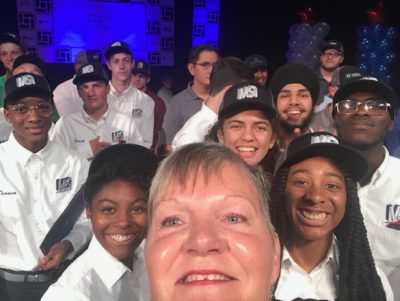 Apprenticeship has a long history as a workforce solution that has been recently revived to meet new labor and economic challenges. Right now, there is significant momentum across the United States to advance formal apprenticeship programs, in a variety of sectors, for high school students and new graduates.
Apprenticeship has a long history as a workforce solution that has been recently revived to meet new labor and economic challenges. Right now, there is significant momentum across the United States to advance formal apprenticeship programs, in a variety of sectors, for high school students and new graduates.
Despite youth apprenticeship’s popularity, little has been written about strategies to ensure access and equity. According to a new report from the North Carolina Justice Center, all partners involved — K-12, community colleges, community-based organizations, and employers — must be deliberate in their recruiting processes to attract under-represented populations, especially students of color.
Youth apprenticeships are paid, structured programs that prepare high school students, recent graduates, and young adults for a technical trade or occupation. They involve paid on-the-job training, related classroom-based instruction, a progressive pay scale (wages increasing each year as the apprentices learn), and a national journeyman certificate and an associate degree from a community college.
For the past four years, Guilford Apprenticeship Partners (GAP) in Greensboro, North Carolina, has been recruiting high school youth into apprenticeship programs in a variety of industry sectors, including advanced manufacturing, aviation mechanics, IT/cybersecurity, automotive, HVAC, electrical, plumbing, and supply chain. In order to recruit students of color from local county high schools, GAP works directly with career development coordinators, who are in a position to inform students of about apprenticeship opportunities.
But there are challenges. As with any youth opportunity, parents and educators need to be on board. To some, apprenticeship sounds too good to be true. There is also the issue of parental expectations and aspirations for their children. When recruiting students of color, GAP had to help parents (and educators) overcome the perception that these apprenticeships lead to undesirable jobs.
To help break down some of these barriers, GAP hired a marketing firm to help them craft and deliver their message to the community. They held open houses and informational sessions for parents, employers, and students. Their efforts paid off. In November 2018 more than 500 people attended an open house to learn more about youth apprenticeship opportunities.
GAP has also implemented wrap-around support services for their apprentices, including transportation assistance and financial management classes. In addition, the state of North Carolina has a tuition waiver that pays for community college tuition for registered apprentices. This allows apprentices to complete their related educational instruction and receive an associate degree at the local community college, Guilford Technical Community College.
With strong marketing, targeted outreach, and robust support services, GAP has been able to increase the diversity of their apprentices year over year.
The new report, “Making Youth Apprenticeships Equitable and Effective: Lessons From North Carolina,” provides an overview of the barriers to student completion in programs that span four North Carolina counties (not just Guilford) and discusses strategies these programs are using to address these barriers.
Read the executive summary from the North Carolina Justice Center.



